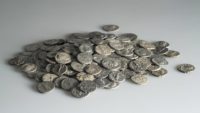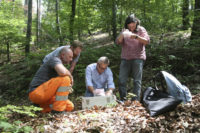 A hoard of 293 silver denarii in excellent condition has been unearthed near Pratteln in northwestern Switzerland. There is no surviving container, but the coins were all found in a small hole together, so they had to have been buried in one event. The coins date from the 1st and 2nd centuries A.D., mostly the latter. The oldest denarius in the hoard was minted under the reign of the Emperor Nero, the youngest in Rome under Commodus in 181/182 A.D. The dates of the most recent coins suggest the hoard was cached at the end of the second century.
A hoard of 293 silver denarii in excellent condition has been unearthed near Pratteln in northwestern Switzerland. There is no surviving container, but the coins were all found in a small hole together, so they had to have been buried in one event. The coins date from the 1st and 2nd centuries A.D., mostly the latter. The oldest denarius in the hoard was minted under the reign of the Emperor Nero, the youngest in Rome under Commodus in 181/182 A.D. The dates of the most recent coins suggest the hoard was cached at the end of the second century.
The total value of the coins at that time would have been significant. Almost 300 silver denarii is the equivalent of half the annual salary of a legionary. It is the second largest assemblage of pure Roman silver ever found in Switzerland, after the treasure of Augusta Raurica (Kaiseraugst) which, while far richer in total weight (58 kilos vs. one kilo) and status pieces (tableware, candelabra, silver bars), its complement of coins was a mere 187. Hoards of thousands of Roman coins have been found, but they are a hundred years younger than the Pratteln coins and the currency was so debased their silver content was practically nil. The denarii of the 1st and 2nd century were 100% silver. The ones of the third century were less than 3% silver.
 The hoard of silver denarii was discovered by Archäologie Baselland volunteer Sacha Schneider while on a metal detecting investigation of the slopes of Mount Adlerberg. It was in a wooded area with no conspicuous features that you might expect to mark the spot of buried treasure, but perhaps there was something notable there in the second century A.D. when the hoard was hidden. Archaeologists would never have found it on their own. They’re primarily engaged in salvage excavations in advance of construction or in exploring known sites, so for the past decade they have enlisted volunteers like Schneider to explore the wider landscape and report anything they find. She alerted archaeologists in the Canton capital of Liestal and they excavated the hoard.
The hoard of silver denarii was discovered by Archäologie Baselland volunteer Sacha Schneider while on a metal detecting investigation of the slopes of Mount Adlerberg. It was in a wooded area with no conspicuous features that you might expect to mark the spot of buried treasure, but perhaps there was something notable there in the second century A.D. when the hoard was hidden. Archaeologists would never have found it on their own. They’re primarily engaged in salvage excavations in advance of construction or in exploring known sites, so for the past decade they have enlisted volunteers like Schneider to explore the wider landscape and report anything they find. She alerted archaeologists in the Canton capital of Liestal and they excavated the hoard.
Today a suburb of Basel, the whole village of Pratteln is on the Federal Inventory of Swiss Heritage Sites and is one of the earliest known areas in the country to have been settled. The oldest artifact ever discovered in Switzerland, a 100,000-year-old hand axe, was found there in 1974. While the village as it is today was built around a monastery and castle in the 11th or 12th century, archaeological remains from the Neolithic, Celtic Iron Age and Roman Empire are evidence of that the area was occupied for millennia.
One of Pratteln’s Roman villas, the rural estate of Kästeli, was one of the largest country homes in the vicinity of Augusta Raurica. The Church of Saint Leodegar at the epicenter of Pratteln’s old town was built in the 13th century over the remains of a Roman villa. That villa would have had a clear view of the Adlerberg slope were the treasure was buried.
How Cool
😮 Caesar Augustus took possession of ‘Raurica’. Therefore, we talk of ‘Augusta Raurica’ and, hence of, what we currently know -rendered into German- as the town of ‘Kaiseraugst‘ on the south bank of the Rhine in Switzerland, opposite to where today Germany begins on the north bank.
A few meters to the West, Pratteln and -in Germany- Grenzach (Carantiacum) were likewise Roman, but obviously more rural. Almost certainly, there has been a bridge. Ptolemy, however, described in the 2nd century AD in Egypt probably what -elsewhere- is referred to as the ‘agri decumates’. One might at least wonder here, if the ‘agri decumates’ and the ‘Helvetian Wasteland’ (τῶν Ἐλουητίων Ἔπρημος), mean the same area. OK, if there really was a ‘wasted land’, there is at least the possibilty that there was indeed no bidge, or one that got destroyed.
Ptolemy wrote:
————
..καὶ ἔτι Ἰντούεργοι καὶ Οὐαργιωνες καὶ Καριτνοὶ, ὑφ’ οὓς Οὐισποὶ καὶ ἡ τῶν Ἐλουητίων Ἔπρημος μέχρι τῶν εἰρημένων ἀλπείων ὀρέων
..then the Intuergi [in between the Rhine and the Taunus], the Vargiones and the Caritni [in western Bavaria], below of which the Vispi [a.k.a. Usipetes or Usipii] and the ‘Helvetian Wasteland’ down to the mountains of the Alps [and the upper Rhine].
————
Either way, those silver coins are either ‘about-to-be laundered’ money, they had reasons not to open an account in Switzerland, or their funds simply had to be saved from violent Alemannic (re)incursions, using boats. In Regensburg [found in the well of roman villa rustica in Burgweinting] sombody took a Roman scalp, i.e. minus the obviously female skull, but it is not exactly sure, who the culprit could have been.
On a sidenote, but referring to another :skull: , the two most frequently measured cosmogenic nuclides are beryllium-10 and aluminum-26, and surface exposure dating seemingly estimated the age of the ‘Pratteln hand axe’ at 300K years. Thus, a suitable candidate for an ancient user would be cousins of the so-called ‘Steinheim skull’, a fossilized skull of a Homo heidelbergensis, but certainly no ‘Homini sapientes’
None of the Roman denarii of the late First or the Second Century AD were pure silver from the late reign of Nero on. The closet to that might have been some of the denarii of Domitian from early in his reign, above 90% pure silver. Other than his denarii they trend from about 90% down to 50%
I was going to make the same comment until I saw yours. I would add that the purer denarii of Domitians reign are more rare because many were melted because of their purity.
The purer denarii of Domitians reign may be more rare because they have yet to come out of the ‘closet’. 😉
:excellent piiece of information.I only wish that J had.
made this discovery ,!